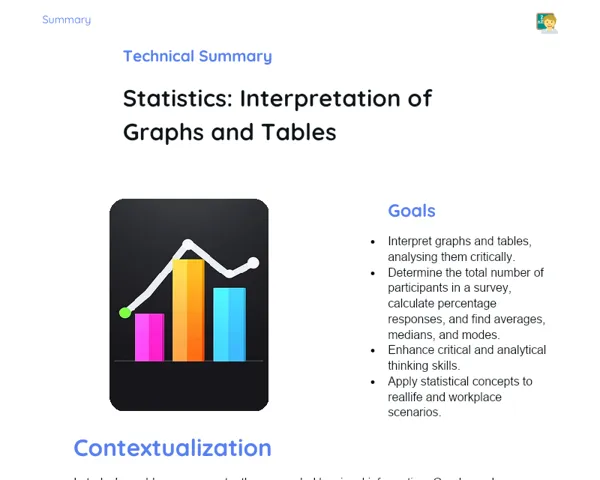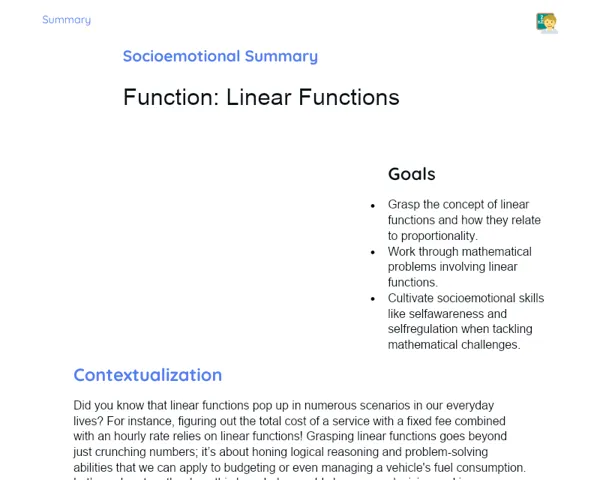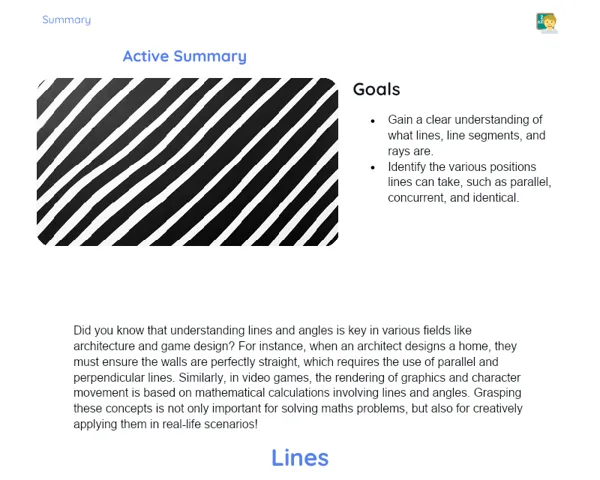Summary Tradisional | Data Representation
Contextualization
In today's world, we're constantly bombarded with data – from rugby match stats and weather updates to public opinion surveys and more. It's crucial to be able to clearly understand and represent this data, as it's key for making well-informed decisions and communicating complicated information effectively. As such, organizing and visualizing data is a fundamental skill in our daily lives.
Data can be represented in various ways, each carrying its own pros and cons. Tables, bar charts, pie charts, line graphs, and spreadsheets are some of the most popular options. Each of these tools provides a distinct way of visualizing information, making it easier to interpret and analyse the data at hand. In this lesson, we'll delve into the process of converting data from a table into different types of graphs, and we'll discuss in which scenarios each type of graph is most suitable.
To Remember!
Data Table
A data table is a structured method of organizing information, arranged in rows and columns. Each row typically represents a record or entry, while each column signifies a variable or characteristic of the data. For instance, in a table recording the favourite fruits of a group of learners, each row could represent a learner and each column a type of fruit, showing how many learners prefer each type.
Tables are extremely handy for managing and visualizing large amounts of data without chaos. They promote easier reading and interpretation of information, helping identify patterns and trends. Moreover, tables serve as the groundwork for creating many different types of graphs, such as bar graphs and pie charts, which present data in a more intuitive way.
Creating a data table entails gathering relevant information and organizing it in a clear and structured layout. It's vital to include a descriptive title for the table and to clearly label each column, ensuring that anyone referencing the table can easily grasp the data presented. Additionally, accuracy and consistency of the data are crucial to prevent misunderstandings.
-
Organises data in rows and columns.
-
Facilitates easy reading and interpretation of data.
-
Serves as a foundation for graph creation.
Bar Chart
A bar chart is a visual tool that employs rectangular bars to represent numerical data. Each bar denotes a different category, and the height or length of the bar corresponds to the value of that category. For example, in a bar chart depicting learners' fruit preferences, each bar would represent a different fruit, and the bar's height would indicate the number of learners who prefer that fruit.
Bar charts are particularly effective for comparing quantities across various categories. They offer a quick and clear visual comparison of differences, making it easier to spot trends and patterns in data. Furthermore, bar charts can be tailored to fit various contexts, from analysing research data to illustrating financial information.
To create a bar chart, one must first collect and organize the data into a table. The information is then plotted on the chart, placing the categories on the x-axis and the values on the y-axis. It's essential for the chart to have a clear title and for the axes to be accurately labelled for easy data interpretation.
-
Visual representation of numerical data.
-
Clear comparison across different categories.
-
Adaptability in various contexts.
Pie Chart
A pie chart is a visual representation that employs slices of a circle to show the proportions of different categories within a data set. Each slice of the chart signifies a category, and the size of the slice is proportional to that category's percentage or fraction relative to the whole. For instance, in a pie chart that illustrates fruit preferences among learners, each slice would represent a fruit, and the size of the slice would indicate the proportion of learners who favour that fruit.
Pie charts excel at visualizing the composition of a data set, demonstrating how the parts relate to the whole. They are particularly effective for showcasing the largest or smallest contributions of each category within the set. However, pie charts tend to be most effective with a limited number of categories, as too many slices can render the chart hard to read and interpret.
To create a pie chart, we first gather and organize the data into a table. Then, we convert the values of each category into proportions or percentages and plot them as slices of a circle. A clear title is essential for the chart, and it's important that each slice is accurately labelled for straightforward comprehension.
-
Visual representation of the proportions within a data set.
-
Illustrates each category's contribution to the overall picture.
-
Ideal for data sets with a limited number of categories.
Line Graph
A line graph uses lines connecting points to represent quantitative data over a continuous range, usually time. Each point represents a value at an exact moment, with the connecting lines showing trends or changes over time. For instance, a line graph depicting temperature fluctuations over a week will have points that correspond to daily temperatures, with lines connecting those points to illustrate the week's trend.
Line graphs are especially effective for visualizing trends and patterns in data across time. They help in spotting seasonal behaviours, fluctuations, and overall trends in a clear, intuitive manner. Additionally, line graphs are often employed in financial, scientific, and research analyses to track changes and to predict future outcomes.
To create a line graph, one must collect and organize data into a table, with one axis representing time and the other representing values. The data points are then plotted and connected by lines to showcase the trend. A clear title for the graph and correctly labelled axes are crucial for easy interpretation of the data.
-
Visual representation of data along a continuous range.
-
Enables identification of trends and patterns over time.
-
Common use in financial, scientific, and research contexts.
Key Terms
-
Data Table: Structure for organizing information in rows and columns.
-
Bar Chart: Visual representation of quantitative data using bars.
-
Pie Chart: Visual representation of proportions using slices of a circle.
-
Line Graph: Visual representation of data across a continuous range using lines connected by points.
-
Spreadsheets: Digital tools for data entry, organization, and manipulation, enabling automatic graph generation.
Important Conclusions
In this lesson, we examined various ways to represent data, including tables, bar charts, pie charts, and line graphs. Each method provides a unique lens through which to interpret and analyse the data. We also highlighted the significance of each type of graph and when they are best utilised.
The ability to convey and understand data is essential in our modern world; it fosters informed decision-making and enhances the clarity of complex information. Whether in an educational, professional, or personal context, mastering the art of visualizing and analysing data is an invaluable skill applicable in numerous real-life situations.
We encourage learners to keep exploring this topic by leveraging tools like spreadsheets to manipulate data and generate graphs automatically. Regular practice and applying the concepts learned in practical scenarios will reinforce and deepen their understanding of data representation.
Study Tips
-
Revisit the concepts covered in class by creating personal examples of tables and graphs using fictional or real data.
-
Utilize digital platforms like Excel or Google Sheets to practice data entry and automatic graph creation.
-
Research and learn about different types of graphs and their applications in daily life, noting how they are used in news articles, reports, and presentations.



